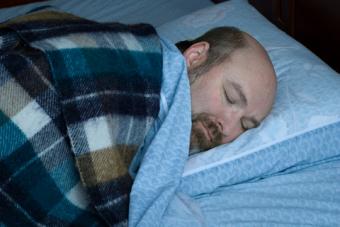
REM behavior disorder affects the person's natural REM cycle, which normally involves non-rapid eye movement and rapid eye movement. The normal progression of the stages of sleep is disrupted when the sleep behavior disorder is present.
Sleep Cycles
People naturally experience five stages of sleep that include one rapid eye movement (REM) stage and four non-rapid eye movement (NREM) stages. When the sleeping individual falls into the rapid eye movement stages, the following conditions manifest:
- Increased blood pressure
- Irregular breathing
- Eyes move rapidly
- Heightened brain activity
- Paralysis (a loss of muscle tone)
- Dreaming
People normally experience REM during roughly one-fourth of the rest period. When a person has REM behavior disorder, the natural cycle of sleep does not occur.
REM Behavior Disorder
REM sleep behavior disorder (RBD) involves the lack of paralysis during sleep. When a sleeping person enters rapid eye movement, the brain is very active, as if the person were awake. The loss of muscle tone helps to prevent the sleeper from moving, or "acting out" dreams. In addition to the lack of paralysis, the person experiences very intense dreams that may be violent.
The vivid nature of the dreams leads to the behavioral patterns associated with RBD. When a person has this condition some troublesome behaviors arise, which may include:
- Yell
- Talk
- Sit up
- Jump out of bed
- Grab
- Flail
- Punch
- Kick
The sleep disorder occurs most often in middle-aged and elderly people. Males tend to have RBD more often than women do.
Causes of RBD
No one knows the specific causes of RBD. However, temporary episodes of the sleep disruption are associated with withdrawal from hypnotic sedatives or alcohol. Some connections to neurological problems have been made to REM sleep behavior disorder.
Neurological Conditions
The relationship between neurological problems and REM sleep behavior disorder are complicated. Some individuals experience the sleep disorder after the neurological condition appears. Others experience the sleep problem before the neurological conditions develop. Rapid eye movement disorder is not always present with degenerative neurological conditions and it does not always indicate that a degenerative neurological condition will develop in the future.
Conditions that may contribute to the sleep disorder include:
- Multiple system atrophy
- Parkinson's disease
- Shy-Drager syndrome
- Lewy body dementia
Each of these conditions is a degenerative neurological problem that involves brain functioning impairments that interfere with the body's natural rhythms and motor control. In some cases, RBD may be symptoms of withdrawal from certain substances such as:
- Tricyclic antidepressants
- SSRI (serotonin reuptake inhibitors)
- Hypnotic sedatives
- Alcohol
- Mirtazapine antidepressant
RBD Treatment
Treatments for REM sleep behavior disorder vary according to the source of the problem. Approaches include medication and supplements, lifestyle changes, and precautionary methods.
Medical Interventions
Medical interventions begin with proper diagnosis. Some patients can benefit from participating in a sleep study to ensure that they are being treated for the right condition. Once a diagnosis is established, medication therapy is often used to treat the condition.
- Clonazepam is a tranquilizer that is a popular choice for treating RBD, with most patients experiencing complete relief from the behaviors. However, the medication can affect balance, can cause daytime sleepiness, and it can worsen sleep apnea symptoms.
- Melatonin is a supplement available in drugstores without prescription. This approach is effective for some, but not everyone finds relief when using melatonin. This supplement is still under investigation as a treatment for RBD.
Lifestyle Changes
Some patients can benefit from making changes in lifestyle that are conducive to better sleep hygiene. This involves avoiding alcohol and certain medications. Establishing a consistent sleep routine and treating underlying sleep disorders can help alleviate the symptoms as well. In addition to lifestyle changes, some precautionary measures may be appropriate. Some people who have this condition find that the violent nature of the dreams manifest in violent actions during sleep. This poses serious risk for them and their sleeping partners.
- Move bedside objects away from the area
- Put pillows or other padding on the floor
- Keep the bed away from mirrors and windows
- Purchase a padded headboard
- Sleep alone until the behaviors cease
Medical Follow Ups
Anyone who has REM behavior disorder should make sure to have regular examinations. The condition can be associated with degenerative neurological disorders that require treatment.







